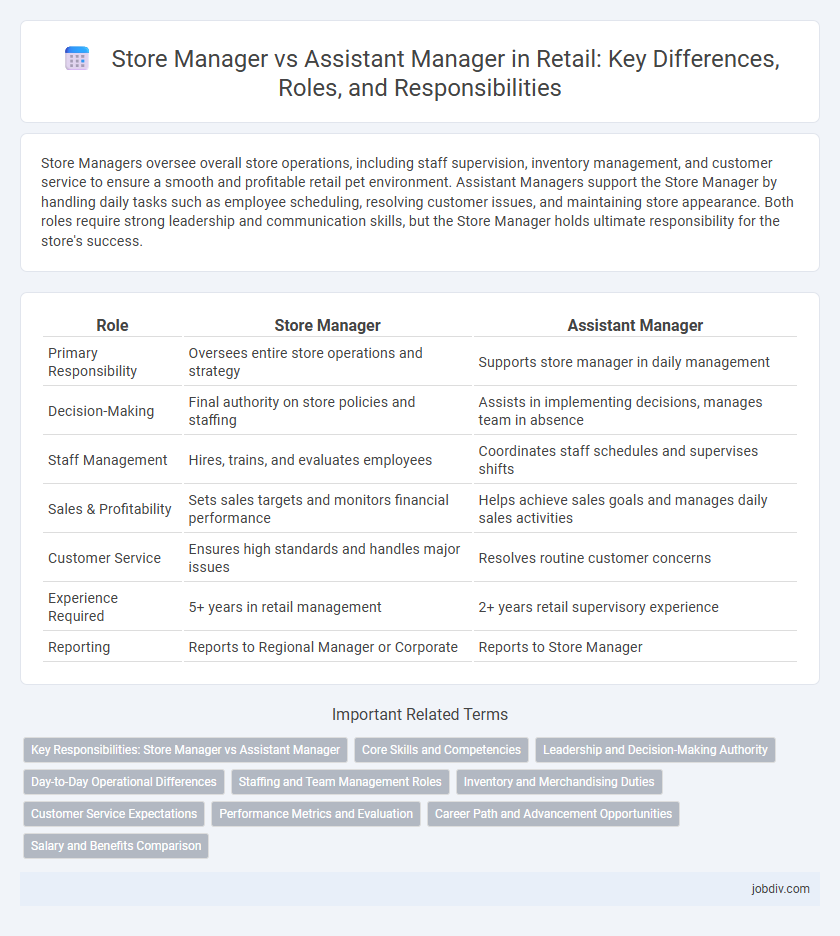Store Managers oversee overall store operations, including staff supervision, inventory management, and customer service to ensure a smooth and profitable retail pet environment. Assistant Managers support the Store Manager by handling daily tasks such as employee scheduling, resolving customer issues, and maintaining store appearance. Both roles require strong leadership and communication skills, but the Store Manager holds ultimate responsibility for the store's success.
Table of Comparison
| Role | Store Manager | Assistant Manager |
|---|---|---|
| Primary Responsibility | Oversees entire store operations and strategy | Supports store manager in daily management |
| Decision-Making | Final authority on store policies and staffing | Assists in implementing decisions, manages team in absence |
| Staff Management | Hires, trains, and evaluates employees | Coordinates staff schedules and supervises shifts |
| Sales & Profitability | Sets sales targets and monitors financial performance | Helps achieve sales goals and manages daily sales activities |
| Customer Service | Ensures high standards and handles major issues | Resolves routine customer concerns |
| Experience Required | 5+ years in retail management | 2+ years retail supervisory experience |
| Reporting | Reports to Regional Manager or Corporate | Reports to Store Manager |
Key Responsibilities: Store Manager vs Assistant Manager
Store Managers oversee overall store operations, including staff management, inventory control, and financial performance to ensure profitability and customer satisfaction. Assistant Managers support the Store Manager by supervising daily activities, managing employee schedules, and handling customer service issues to maintain smooth store functions. Both roles require leadership skills, but the Store Manager holds ultimate responsibility for strategic decisions and store success.
Core Skills and Competencies
Store Managers excel in leadership, strategic planning, and inventory management, driving sales performance through team motivation and operational oversight. Assistant Managers focus on customer service, staff supervision, and daily task execution, supporting the Store Manager in maintaining smooth store operations. Both roles require strong communication, problem-solving abilities, and a deep understanding of retail metrics to ensure business success.
Leadership and Decision-Making Authority
Store Managers hold primary leadership responsibility and possess comprehensive decision-making authority, overseeing daily operations, staff management, and strategic planning. Assistant Managers support the Store Manager by executing delegated tasks, managing team members during shifts, and providing input for operational decisions without having full authority. The distinction in leadership lies in the Store Manager's accountability for final decisions and overall store performance, whereas Assistant Managers function as operational leaders with limited autonomy.
Day-to-Day Operational Differences
Store Managers oversee overall store performance, including sales targets, inventory management, and staff scheduling to ensure smooth daily operations. Assistant Managers handle frontline responsibilities such as resolving customer issues, supervising employee tasks, and maintaining store appearance during the manager's absence. The Store Manager focuses on strategic decisions and financial outcomes, while Assistant Managers support operational execution and team coordination on the ground.
Staffing and Team Management Roles
Store Managers oversee overall staffing strategies, including recruitment, training, and performance evaluations, ensuring team alignment with sales goals and customer service standards. Assistant Managers focus on daily team management tasks, such as scheduling, employee motivation, and resolving immediate staffing issues to maintain operational efficiency. Effective collaboration between these roles drives workforce productivity and enhances store performance in the retail environment.
Inventory and Merchandising Duties
Store Managers oversee overall inventory accuracy, ensuring stock levels align with sales forecasts, and lead merchandising strategies to maximize product visibility and sales. Assistant Managers support these efforts by organizing inventory counts, replenishing stock on shelves, and maintaining merchandising standards according to company guidelines. Both roles collaborate closely to optimize stock turnover and enhance the shopping experience through effective inventory control and attractive product displays.
Customer Service Expectations
Store Managers are expected to set strategic customer service standards, ensuring consistent delivery of high-quality experiences across all touchpoints. Assistant Managers support these goals by directly supervising staff interactions, addressing customer concerns promptly to maintain satisfaction and loyalty. Both roles require strong communication skills and a proactive approach to resolving issues, but Store Managers concentrate on performance metrics while Assistant Managers focus on day-to-day operational excellence.
Performance Metrics and Evaluation
Store Managers are evaluated on overall sales growth, profit margins, and inventory turnover rates, demonstrating leadership in achieving business objectives. Assistant Managers focus more on day-to-day operational efficiency, customer satisfaction scores, and staff performance metrics to support smooth store functioning. Performance evaluations for both roles incorporate employee retention rates and compliance with company policies to ensure sustained organizational success.
Career Path and Advancement Opportunities
Store Managers typically oversee overall store operations, with responsibilities including staff management, sales targets, and inventory control, positioning them for higher leadership roles like District Manager. Assistant Managers support daily store functions and gain hands-on experience in team supervision and customer service, serving as a crucial step in the career ladder toward Store Manager positions. Advancement opportunities for Assistant Managers often include specialized training programs and mentorship designed to develop skills necessary for managing larger teams and more complex store operations.
Salary and Benefits Comparison
Store Managers in retail typically earn between $50,000 and $80,000 annually, reflecting higher responsibility and leadership roles compared to Assistant Managers, whose salaries range from $35,000 to $55,000. Benefits for Store Managers often include performance bonuses, profit sharing, and enhanced health insurance packages, whereas Assistant Managers may receive standard benefits with fewer incentives. The salary gap is influenced by the Store Manager's accountability for overall store performance, employee management, and strategic planning.
Store Manager vs Assistant Manager Infographic

 jobdiv.com
jobdiv.com